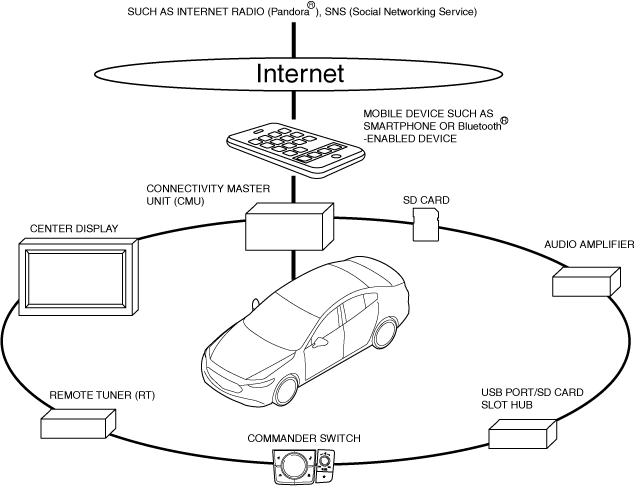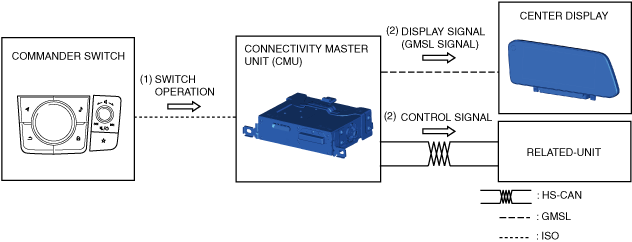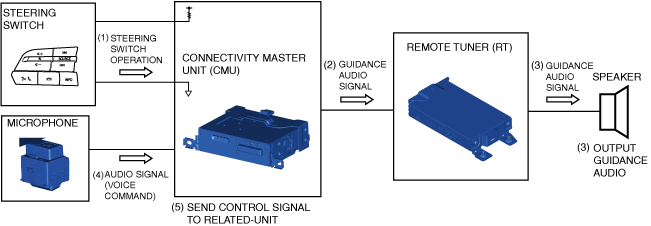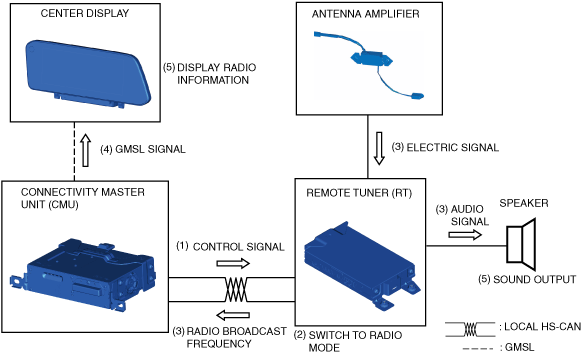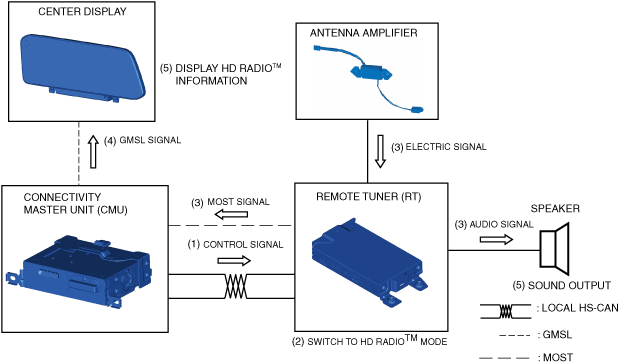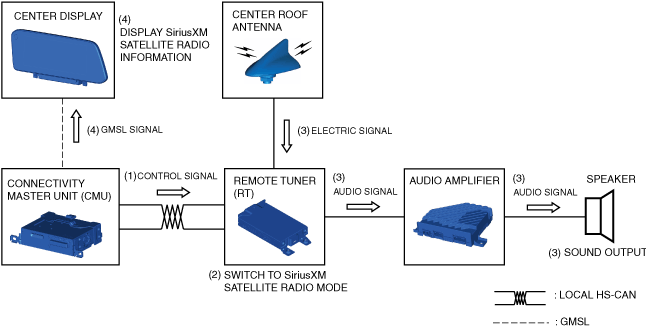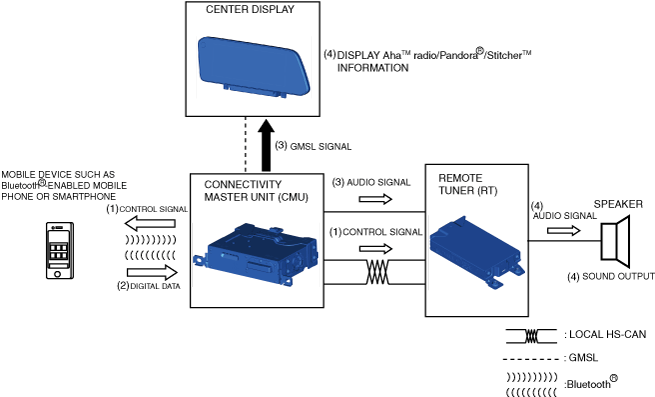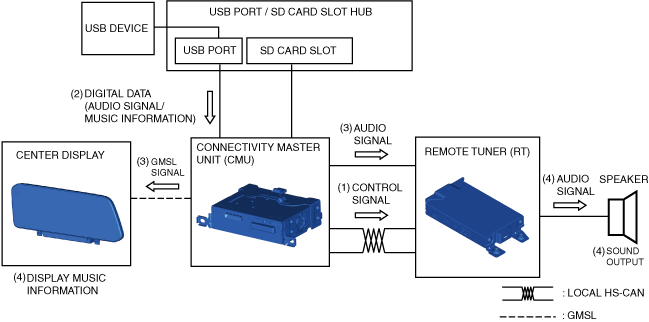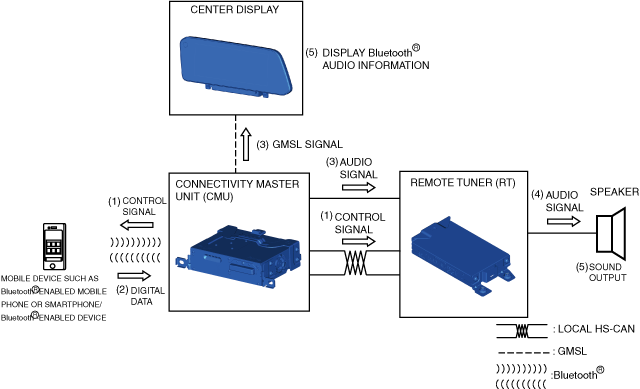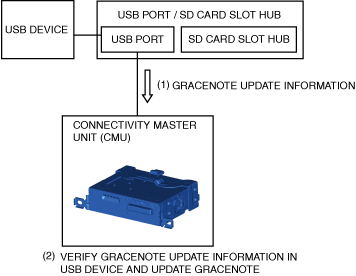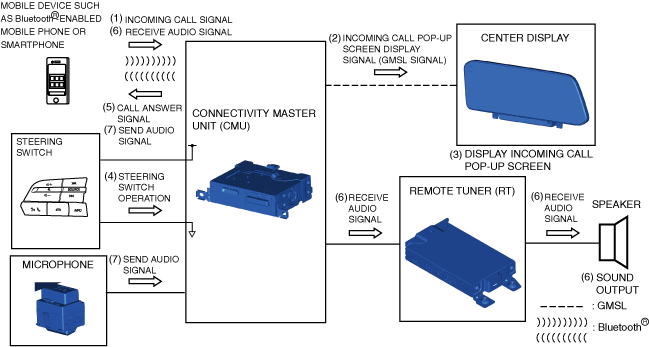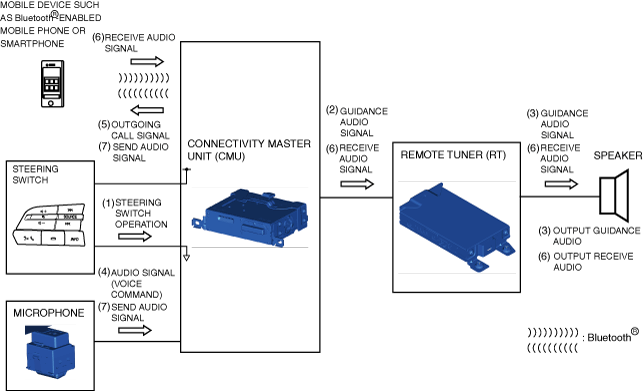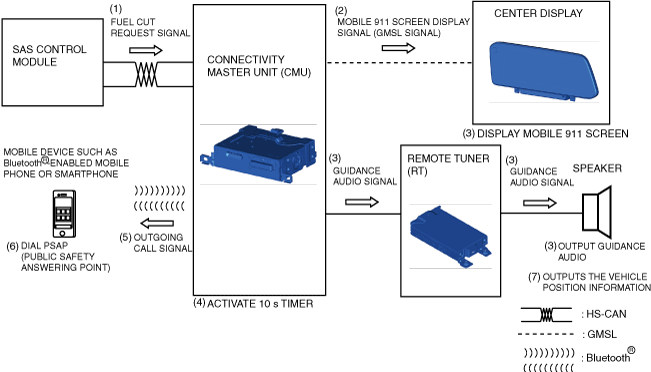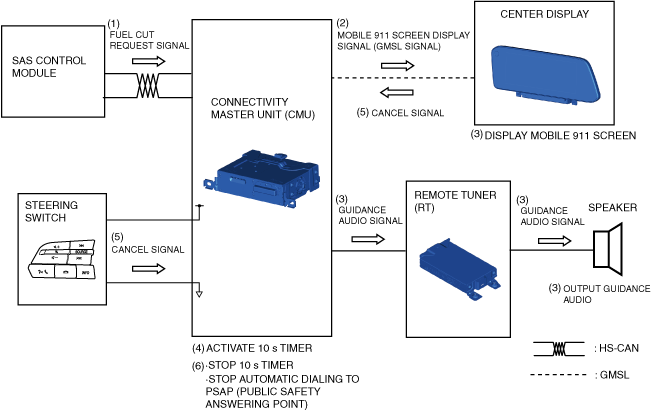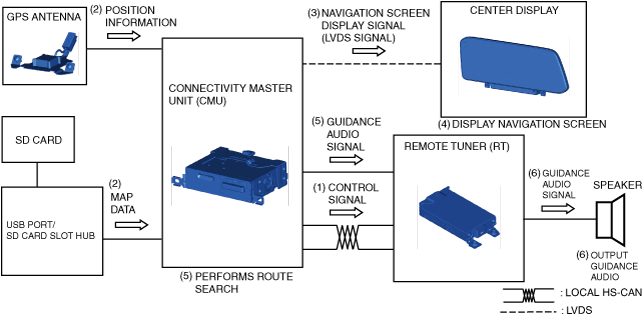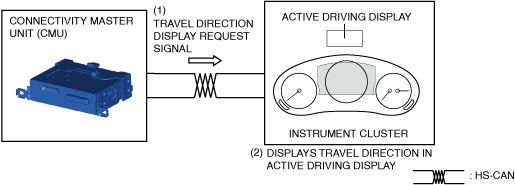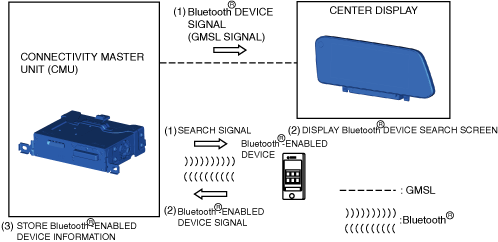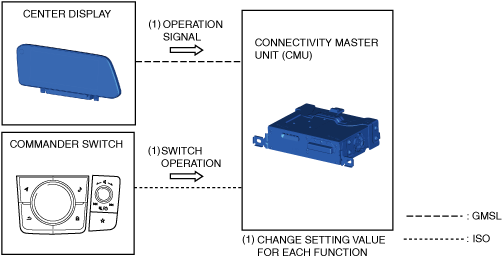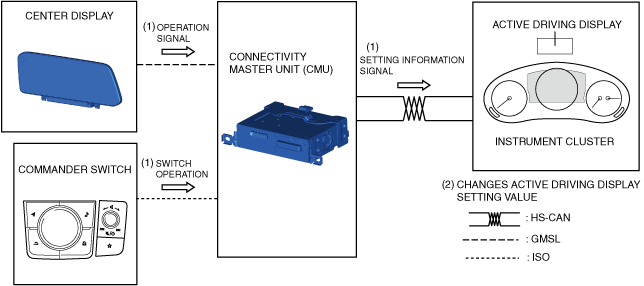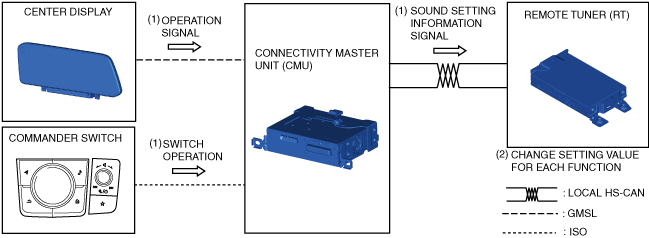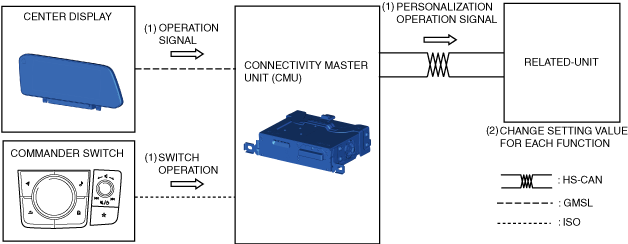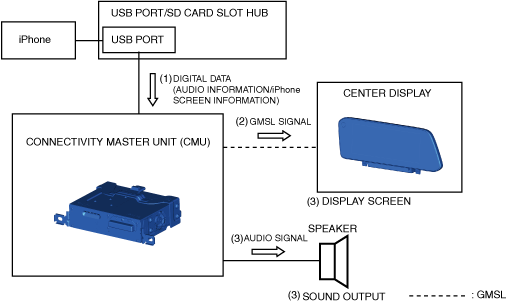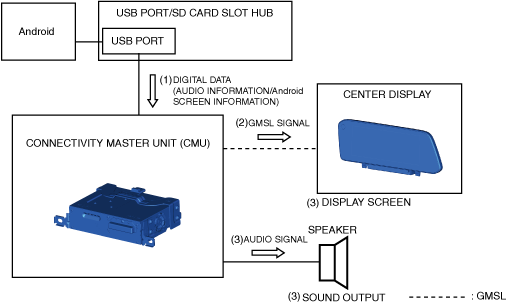ENTERTAINMENT SYSTEM [(US)]
ENTERTAINMENT SYSTEM [(US)]
SM2566532
id1600000001a1
-
Note
-
• iPod, iPhone, and Apple CarPlay are registered trademarks of Apple Inc.• Android, and Android Auto are registered trademarks of Google LLC.
Outline
Schematic Diagram
bmcozp00000368
|
Reference List Table
|
Item
|
Content/function
|
Reference
|
|
Operation signal reception
|
The entertainment system receives operation signals sent from the center display, commander switch, or the voice recognition function to operate each function.
|
Operation
(See Operation signal reception.)
|
|
Audio function
|
• Music media listening such as radio and iPod is available.
• Video media playing such as USB media is available.
|
Function
(See Audio function.)
Operation
(See Audio function.)
|
|
Communication function
|
SMS (Short Message Service), SNS (Social Networking Service), and Bluetooth ® Hands-free functions are available.
|
Function
(See Communication function.)
Operation
(See Communication function.)
|
|
Navigation function
|
Provides guidance and information to destination.
|
Function
(See Navigation function.)
Operation
(See Navigation function.)
|
|
Setting function
|
Changes the vehicle settings such as for the center display screen, sound quality/volume.
|
Function
(See Setting function.)
Operation
(See Setting function.)
|
|
Application function
|
The fuel efficiency monitor, vehicle status monitor, owner’s mannul and warning guidance information can be verified.
|
Function
(See Application function.)
Operation
(See Application function.)
|
|
Structural diagram
|
—
|
(See Structural View.)
|
|
System diagram
|
—
|
(See Operation.)
|
Function
Audio function
-
AM/FM radio
-
• AM and FM radio broadcast can be listened to.• A condenser has been adopted for noise reduction.
-
HD radio ™
-
• HD radio ™ can be listened to.
-
Note
-
• HD radio ™ broadcasts deliver digital audio quality like a CD. Display of song information (genre type, song title, artist name, album title) during a broadcast is also available. HD radio broadcasts may also include several channels (multi-cast channels) in the same frequency. A maximum of 7 multi-cast channels can be received.
-
SiriusXM satellite radio
-
• Satellite radio broadcasts can be listened to.
-
Pandora ® *1
-
• By downloading an application to a mobile device such as a Smartphone and pairing with the connectivity master unit (CMU), Internet broadcasts (Pandora ®) can be listened to.
-
Note
-
• Pandora ® is non-fee, personalized Internet radio. Pandora ® is not simply an application for playing user requests, rather it is used to create a personalized station by matching the user’s likes using key words such as artist and song name input by the user, and providing the music.
-
USB audio
-
• By connecting an on-market portable audio/USB device/USB port/SD card slot hub, audio from the external device can be listened to.
-
USB video
-
• By connecting an on-market USB device/USB port, video from the external device can be listened to.
-
Bluetooth ® audio
-
• By pairing a Bluetooth ®-enabled device with the CMU, audio from the Bluetooth ® device can be listened to.
-
Gracenote
-
• The CMU supports Gracenote. Gracenote can perform updates by connecting a USB in which update information has been saved to the USB port/SD card slot hub.
-
Note
-
• Music recognition technology and related data are provided by Gracenote ®. Gracenote is the industry standard for music recognition technology and related content delivery. For detailed information, refer to the Website (www.gracenote.com).
-
Centerpoint ® *2
-
• Centerpoint ® is a virtual surround sound function for vehicles. The 5.1-channel surround signal converted using an independently optimized algorithm delivers three-dimensional, well-balanced surround acoustics from the 9 speakers equipped on the vehicle to passengers. Centerpoint ® can be set to ON/OFF.
Communication function
-
SMS (Short Message Service)
-
• By pairing a mobile device such as a Bluetooth ®-enabled mobile phone or a Smartphone to the CMU, and SMS received by these mobile devices can be viewed on the center display.
-
Bluetooth ® (Hands-Free) function
-
• Answering and receiving telephone calls can be performed without having to directly connect a Bluetooth ®-enabled mobile device such as a mobile phone or Smartphone.
-
Mobile 911 (U.S.A./Canada)
-
• Mobile 911 is a function which automatically calls a PSAP (Public Safety Answering Point) in the event that the vehicle is involved in an accident using a mobile device such as a Bluetooth ® enabled mobile phone or Smartphone to notify the PSAP of the vehicle position and to conduct a call.
-
Note
-
• Depending on how the vehicle was affected by the collision, a malfunction in the communication system could occur, and depending on the condition of the related parts, Mobile 911 may not operate normally.
Navigation function
-
Map display, route guidance
-
• Calculates routes to the destination set by the user and provides guidance using maps and audio.
-
Turn-by-turn (TBT)
-
• Direction heading and distance to branch points are displayed in the active driving display.
Setting function
-
Bluetooth ® pairing
-
• Pairing of a Bluetooth ®-enabled device can be performed.
-
Note
-
• For the Bluetooth ® pairing set up method, refer to the Bluetooth ® PAIRING PROCEDURE in the workshop manual.
-
Clock settings
-
• The following items can be set using the clock setting.
|
Item |
Content |
|---|---|
|
Manual Time Adjustment
|
Displays the currently set time. When + is selected, the time/minutes move forward, and when – is selected, the time/minutes move back. AM/PM selection is only possible during 12-hour clock time display.
|
|
GPS Time Synchronization
|
Synchronizes to the GPS time.
|
|
24-Hour Clock
|
Changes the display between 12 and 24-hour clock time.
|
|
Daylight Saving Time
|
Enables or desables daylight saving time.
|
|
Time Zone
|
Selects the time zone.
|
-
Driver settings
-
• The following items can be set using the driver setting.
|
Item |
Content |
|---|---|
|
Driver Identification
|
Automatically identifies the driver based on the key.
|
|
Driver Selection
|
Manually selects the desired driver.
|
|
Edit Driver Name(s)
|
Edits the name of the selected driver.
|
-
Voice Recognition Settings
-
• Configures voice recognition and voice guidance settings.
|
Item |
Content |
|---|---|
|
Guidance Volume
|
Adjusts the volume of the Voice Guidance responses.
|
|
Guidance Length
|
Selects the length of Voice Guidance responses.
|
|
Barge-In
|
Allows user to interrupt with desired commands during Voice Guidance responses.
|
-
System setting
-
• The following items can be set using the system setting.
|
Item |
Content |
|---|---|
|
Tool Tips
|
The function for displaying supplemental explanations of functions is switched on/off in conjunction with the highlighting of the commander switch operations.
|
|
Language
|
The language can be changed.
|
|
Temp
|
Switches temperature unit between °F / °C *5
|
|
Distance / Speed
|
The distance unit can be switched between miles/km *6.
|
|
Fuel Efficiency
|
Selects the desired unit of expression for fuel efficiency.
|
|
Pressure
|
Selects the desired unit of air pressure.
|
|
Gracenote Database Update
|
Gracenote is updated.
|
|
Use Gracenote Database Album Art
|
Utilizes Gracenote Database for displayed Album Art.
|
|
ETC Volume
|
Sets the alert volume for ETC notifications.
|
|
System Information
|
Displays system software information.
|
|
Restore All Factory Settings
|
Settings other than sound are reset to the factory settings.
|
-
Display setting
-
• The following items can be set using the display setting.
|
Item |
Content |
|---|---|
|
Display Off
|
Turns off the center display screen.
|
|
Day/Night Mode
|
Selects the center display brightness mode.
|
|
Brightness
|
Adjusts the display brightness.
|
|
Contrast
|
Adjusts the display contrast.
|
|
Show Drive Results at Ignition Off
|
Provides energy efficiency results at the end of the drive.
|
|
Home Screen Clock
|
Selects the clock style displayed on the Home screen.
|
|
Ambient Display
|
Enables a simplified interface accessible from the Home screen.
|
|
Restore Factory Settings
|
Resets the display to the factory settings.
|
-
Sound settings
-
• The following settings are available for the sound quality.
|
Item |
Content |
|---|---|
|
Sound Adjustment Mode
(Selects a Basic or Advanced sound adjustment)
|
Basic/Advanced
|
|
Bass
(Bass adjustment)
|
+ Side: Increased bass
– Side: Decreased bass
|
|
Treble
(Treble adjustment)
|
+ Side: Increased treble
– Side: Decreased treble
|
|
Equalizer
(Selects or creates the desired equalizer curve)
|
Flat/Pop/Rock/Jazz/R&B/Classical/Custom 1/Custom 2/Custom 3/Customize EQ
|
|
Listening Position
(Selects the desired listening position)
|
Driver’s Seat/All Seats
|
|
Fade
(Front/rear volume adjustment)
|
Front side: Front speaker volume decrease
Rear side: Rear speaker volume decrease
|
|
Balance
(Left/right volume adjustment)
|
Left side: Increase left side speaker volume
Right side: Right side speaker volume increase
|
|
ALC *7
(Auto volume adjustment)
|
OFF/Level 1/Level 2/Level 3/Level 4/Level 5/Level 6/Level 7
|
|
Automatic Source Level Adjustment
(Automatically stabilizes volume levels across sources)
|
Enable/Disable
|
|
Bose® Stereo Mode
(Selects the desired stereo listening experience)
|
Standard/Linear
|
|
Bose® Centerpoint *8
(Automatic surround level adjustment)
|
OFF/Level 1/Level 2/Level 3
|
|
Bose® AudioPilot *8
(Automatic volume adjustment)
|
OFF/Level 1/Level 2/Level 3
|
-
Vehicle notification and warning volume
-
• Adjusts the alert volume for notifications and warnings.
|
Content |
|---|
|
Low/Moderate/High
|
-
Volume setting
-
• The volume can be adjusted by operating the volume dial on the command switch or the volume button on the steering switch.
-
Personalization feature setting
-
• The following personalization settings for the system can be changed using the center display. For details, refer to the each system personalization feature.
Application function
-
Fuel efficiency monitor
-
• The fuel consumption display displays the following information in the center display. For details, refer to the fuel consumption display of the [CENTER DISPLAY]. (See CENTER DISPLAY [(US)].)
-
― Fuel consumption
-
-
Vehicle status monitor
-
• The vehicle status monitor displays the following information in the center display. For details, refer to the [CENTER DISPLAY]. (See CENTER DISPLAY [(US)].)
-
― Vehicle Warning Messages― Scheduled Maintenance― Tire Rotation― Oil Change
-
-
Owner’s Manual
-
• The owner’s manual displays the following information in the center display. For details, refer to the fuel consumption display of the [CENTER DISPLAY]. (See CENTER DISPLAY [(US)].)
-
Apple CarPlay™
-
• Apple CarPlay™ can operate iPhone® content such as telephone, messages, music, and maps as one function of the vehicle. For details, refer to the Apple CarPlay™ of the center display. (See CENTER DISPLAY [(US)].)
-
Android Auto™
-
• Android Auto™ can operate Android™ content such as telephone, messages, music, and maps as one function of the vehicle. For details, refer to the Android Auto™ of the center display. (See CENTER DISPLAY [(US)].)
Structural View
Operation
Operation signal reception
-
• Each function of the entertainment system operates if any of the operations in the following table is performed.
|
Function |
Commander switch operation |
Voice recognition function operation (steering switch operation and audio signal (voice command)) |
|
|---|---|---|---|
|
Audio function
|
AM/FM radio
|
×
|
×
|
|
HD radio ™
|
×
|
×
|
|
|
SiriusXM satellite radio
|
×
|
×
|
|
|
Pandora ®
|
×
|
×
|
|
|
USB audio / USB video
|
×
|
×
|
|
|
Bluetooth ® audio
|
×
|
×
|
|
|
Centerpoint ® *9
|
—
|
—
|
|
|
Communication function
|
SMS (Short Message Service)
|
×
|
×
|
|
Bluetooth ® (Hands-Free) function
|
×
|
×
|
|
|
Navigation function
|
Map display, route guidance
|
×
|
×
|
|
Turn-by-turn (TBT) *10
|
×
|
×
|
|
|
Setting function
|
Bluetooth ® pairing
|
×
|
—
|
|
System setting
|
×
|
—
|
|
|
Screen setting
|
×
|
—
|
|
|
Sound setting
|
×
|
—
|
|
|
Clock setting
|
×
|
—
|
|
|
Personalization feature setting
|
×
|
—
|
|
|
Active drive display setting
|
×
|
—
|
|
|
Application function
|
Fuel efficiency monitor
|
×
|
—
|
|
Vehicle status monitor
|
×
|
—
|
|
|
Apple CarPlay™
|
×
|
—
|
|
|
Android Auto™
|
×
|
—
|
|
-
Operation signal reception from commander switch
-
1. When the commander switch is operated, the CMU detects (1) the commander switch operation.2. The CMU sends (2) the display signal (GMSL signal) to the center display based on the detected commander switch operation. In addition, it sends (2) a control signal to the related units.
bmcozp00000370
|
-
Operation signal reception from voice recognition function
-
1. When the talk button on the steering switch is pressed, the CMU detects (1) the steering switch operation.2. When the CMU detects the steering switch operation, it sends (2) a guidance audio signal to the remote tuner (RT).3. The remote tuner (RT) sends (3) the guidance audio signal to the speakers and the speakers output (3) the guidance audio.4. The voice recognition-use microphone converts the words (voice commands) produced by the user after the guidance audio output to an audio signal and sends it to the CMU.5. The CMU sends (5) the control signal to the related parts based on the audio signal received from the voice recognition microphone.
bmcozp00000746
|
Audio function
-
AM/FM radio
-
1. When the CMU receives the operation signal/detects the switch operation, it sends (1) the control signal to the remote tuner (RT).2. When the remote tuner (RT) receives the control signal, it switches (2) the tuner inside the remote tuner (RT) to radio mode and initiates reception of radio broadcasts.3. The remote tuner (RT) detects the radio broadcast selected by the user using the tuner in the remote tuner (RT) based on the electrical signal received (3) from the center roof antenna. The audio signal of the detected radio broadcast is sent (3) to the speakers. In addition, the frequency of the detected radio broadcast is sent to the CMU.4. The CMU converts the radio broadcast received from the remote tuner (RT) to a GMSL signal and sends (4) the GMSL signal to the center display.5. The speakers output (5) the audio based on the audio signal sent from the remote tuner (RT). In addition, the center display indicates (5) radio information based on the GMSL signal.
bmcozp00000747
|
-
HD radio ™
-
1. When the CMU receives the operation signal/detects the switch operation, it sends (1) the control signal to the remote tuner (RT).2. When the remote tuner (RT) receives the control signal, it switches (2) the tuner in the remote tuner (RT) to radio mode and initiates reception of the radio broadcast.3. The remote tuner (RT) detects the radio broadcast of the radio station selected by the user using the tuner in the remote tuner (RT) based on the electrical signal received (3) from the center roof antenna. The audio signal of the detected radio broadcast is sent (3) to the speakers. In addition, the detected radio broadcast logo or album is converted to a RS485 signal and the signal is sent (3) to the CMU.4. The CMU converts the RS485 *12 signal from the remote tuner (RT) to a GMSL signal and sends (4) the GMSL signal to the center display.5. The speakers output (5) the audio based on the audio signal received from the remote tuner (RT). In addition, the center display indicates HD radio ™ information based on the GMSL signal.
bmcozp00000373
|
-
SiriusXM satellite radio
-
1. When the CMU receives the operation signal/detects the switch operation, it sends (1) the control signal to the remote tuner (RT).2. When the remote tuner (RT) receives the control signal, it switches (2) the tuner inside the remote tuner (RT) to SiriusXM satellite radio mode and initiates reception of radio broadcasts.3. The remote tuner (RT) detects the radio broadcast selected by the user using the tuner in the remote tuner (RT) based on the radio station selected by the user. The audio signal from the detected radio broadcast is sent to the speakers. The speakers output (3) the audio based on the audio signal.4. The center display displays (4) the SiriusXM satellite radio information based on the GMSL signal sent from the CMU.
bmcozp00000374
|
-
Pandora ®
-
1. When the CMU receives the operation signal/detects the switch operation, it sends (1) the control signal to the remote tuner (RT) and a mobile device such as a Bluetooth ®-enabled mobile phone or a Smartphone.2. When the mobile device such as a Bluetooth ®-enabled mobile phone or a Smartphone receives the control signal, it receives the Pandora ® send (2) the digital data to the CMU.3. The CMU converts the received video signal of the digital data to a GMSL signal and sends (3) the GMSL signal to the center display. In addition, it sends (3) the audio signal to the remote tuner (RT).4. The center display indicates (4) the radio information based on the GMSL signal received from the CMU. In addition, the remote tuner (RT) sends (4) the received audio signal to the speakers. The speakers output (4) the audio based on the received audio signal.
bmcozp00000375
|
-
USB audio/USB video
-
1. When the CMU receives the operation signal/detects the switch operation, it sends (1) the control signal to the remote tuner (RT).2. The USB port/SD card slot hub sends (2) the digital data (audio signal/music information such as album name or artist name) of the USB device/iPod connected to the USB port to the CMU.3. The CMU transmits (3) the received audio signal to the remote tuner (RT), converts music information to a GMSL signal, and sends (3) it to the center display.4. The center display indicates (4) the music information based on the GMSL signal received from the CMU. In addition, the remote tuner (RT) sends (4) the received audio signal to the speakers and the speakers output (4) the audio based on the received audio signal.
bmcozp00000748
|
-
Bluetooth ® audio function
-
1. When the CMU receives the operation signal/detects the switch operation, it sends (1) the control signal to the remote tuner (RT) and a mobile device such as a Bluetooth ®-enabled mobile phone or a Smartphone.2. When the mobile device such as a Smartphone or a Bluetooth ®-enabled device receives the control signal, the digital data is sent (2) to the CMU.3. The CMU converts the video signal of the digital data to a GMSL signal and sends (3) it to the center display. In addition, it sends (3) the audio signal to the remote tuner (RT).4. The remote tuner (RT) sends (4) the received audio signal to the speakers.5. In addition, the center display indicates (5) Bluetooth ® audio information based on the GMSL signal. In addition, the speakers output (5) the audio based on the received audio signal.
bmcozp00000749
|
-
Gracenote updating
-
1. The USB port/SD card slot hub sends (1) the Gracenote update information on the USB device.2. The CMU verifies the Gracenote update information received from the USB port/SD card slot hub and performs (2) the update.
bmcozp00000378
|
Communication function
-
SMS (Short Message Service)
-
1. When the CMU receives the operation signal/detects the switch operation, it sends (1) a control signal to a mobile device such as a Bluetooth ®-enabled mobile phone or a Smartphone.2. When the mobile device such as a Smartphone or a Bluetooth ®-enabled device receives the control signal, the digital data is sent (2) to the CMU.3. The CMU converts the video signal of the digital data to a GMSL signal and sends (3) the GMSL signal to the center display.4. The center display indicates the SMS information based on the received GMSL signal.
bmcozp00000379
|
-
Bluetooth ® (Hands-Free) function (incoming calls)
-
1. When an incoming call is received, a mobile device such as a Bluetooth ®-enabled mobile phone or a Smartphone sends (1) the incoming call signal to the CMU.2. When the CMU receives the incoming call signal, it sends (2) the incoming call pop-up screen display signal (GMSL signal) to the center display.3. When the center display receives the incoming call pop-up screen display signal (GMSL signal), it displays (3) the incoming call pop-up screen.4. If the pick-up button on the steering switch is pressed while the incoming call pop-up screen is displayed, the CMU detects (4) the steering switch operation.5. When the CMU detects the steering switch operation, it sends (5) the call answer signal to a mobile device such as a Bluetooth ®-enabled mobile phone or a Smartphone, and the call is initiated.6. The mobile device, such as a Bluetooth ®-enabled mobile phone or a Smartphone, sends (6) the received audio signal to the CMU, and the signal is output (6) from the speakers via the remote tuner (RT).7. The voice recognition-use microphone sends the send audio signal of the user to the CMU, and the CMU sends (7) the received send audio signal to a mobile device such as a Bluetooth ®-enabled mobile phone or a Smartphone.
-
Note
-
• When the call initiates, the incoming call pop-up screen switches to the call screen.
bmcozp00000750
|
-
Bluetooth ® (Hands-Free) function (outgoing calls)
-
1. When the talk button on the steering switch is pressed, the CMU detects (1) the steering switch operation.2. When the CMU detects the steering switch operation, it sends (2) a guidance audio signal to the remote tuner (RT).3. The remote tuner (RT) sends (3) the guidance audio signal to the speakers and the speakers output (3) the guidance audio.4. The voice recognition-use microphone converts the words (voice commands) produced by the user after the guidance audio output to an audio signal and sends it to the CMU.5. When the CMU receives the audio signal from the voice recognition-use microphone, it sends (5) an outgoing call signal to a mobile device such as a Bluetooth ®-enabled mobile phone or a Smartphone, and the call is initiated.6. The mobile device, such as a Bluetooth ®-enabled mobile phone or a Smartphone, sends (6) the received audio signal to the CMU, and the signal is output (6) from the speakers via the remote tuner (RT).7. The voice recognition-use microphone sends the send audio signal of the user to the CMU, and the CMU sends (7) the received send audio signal to a mobile device such as a Bluetooth ®-enabled mobile phone or a Smartphone.
bmcozp00000751
|
-
Mobile 911 (Auto outgoing call performed)
-
1. When an accident occurs under specified conditions, the SAS control module sends a fuel cut request signal to the CMU.2. When the CMU receives the fuel cut request signal from the SAS control module, it sends the guidance audio signal to the remote tuner (RT). In addition, it sends the Mobile 911 screen display signal (GMSL signal) to the center display.3. The remote tuner (RT) sends the guidance audio signal to the speakers and the speakers output the guidance audio. In addition, the center display displays the Mobile 911 screen.4. The CMU executes the 10 s timer after the guidance audio output.5. After 10 s have elapsed on the timer, the CMU sends an outgoing call signal to a mobile device such as a Bluetooth ® enabled mobile phone or a Smartphone.6. When the mobile device, such as a Bluetooth ®-enabled mobile phone or a Smartphone, receives the outgoing call signal, it calls the PSAP (Public Safety Answering Point).7. After connecting to the PSAP (Public Safety Answering Point), the CMU outputs the vehicle position information from the vehicle speakers and initiates the call.
bmcozp00000382
|
-
Mobile 911 (Auto outgoing call canceled)
-
1. When the SAS control module operates the air bags, a fuel cut request signal is sent to the CMU.2. When the CMU receives the fuel cut request signal from the SAS control module, it sends the guidance audio signal to the remote tuner (RT). In addition, it sends the Mobile 911 screen display signal (GMSL signal) to the center display.3. The remote tuner (RT) sends the guidance audio signal to the speakers and the speakers output the guidance audio. In addition, the center display displays the Mobile 911 screen.4. The CMU executes the 10 s timer after the guidance audio output.5. If the Cancel Call to 911 operator is selected on the center display/Hang-up button on the steering switch is pressed while the timer executes the 10 s timer, the center display/steering switch sends a cancel signal to the CMU.6. When the CMU receives the cancel signal, it stops the 10 s timer and cancels the auto outgoing call to the PSAP (Public Safety Answering Point).
bmcozp00000752
|
Navigation function
-
Map display, route guidance
-
1. When the CMU receives the operation signal/detects the switch operation, it sends (1) the control signal to the remote tuner (RT).2. The CMU reads (2) the map information of the SD card inserted in the USB port/SD card slot hub. In addition, reception of the position information from the GPS antenna is initiated.3. The CMU sends (3) the navigation screen display signal (GMSL signal) to the center display based on the SD card map information and the position information from the GPS antenna.4. The center display displays (4) the navigation screen based on the received navigation screen display signal (GMSL signal).5. The CMU detects (5) the route to the destination set by the user and sends (5) the guidance audio signal to the remote tuner (RT) after deciding the route.6. The remote tuner (RT) sends (6) the guidance audio signal to the speakers and the speakers output (6) the guidance audio.
bmcozp00000753
|
-
Turn-by-turn (TBT)
-
1. The CMU sends (1) the travel direction display request signal to the instrument cluster.2. The instrument cluster displays (2) the travel direction in the active driving display based on the received travel direction display request signal.
bmcozp00000385
|
Setting function
-
Bluetooth ® pairing
-
1. When the CMU receives the operation signal/detects the switch operation, it transmits a search signal to a Bluetooth ® enabled device near the CMU and sends (1) the Bluetooth ®-device search screen signal to the center display.2. The Bluetooth ®-enabled device near the CMU sends (2) a Bluetooth ® device signal to the CMU. In addition, the center display displays (2) the Bluetooth ® device search screen.3. The CMU programs (3) the Bluetooth ®-enabled device information based on the Bluetooth ® device signal.
-
Note
-
• In the following cases, Bluetooth ® pairing is canceled.
-
― Eight (maximum of 7) Bluetooth ® devices have been programmed― Bluetooth ® device signal is not received during period of 180 s― Cancel is selected during Bluetooth ® device search screen display
-
bmcozp00000386
|
-
System/screen/clock settings
-
1. When the ACU receives the operation signal/detects (1) the switch operation, it changes (1) each function setting based on the information from the user operations.
bmcozp00000387
|
-
Active driving display setting
-
1. When an operation signal is received/switch operation is detected (1), the CMU sends (1) a setting information signal to the instrument cluster based on the information from the user operations.2. The instrument cluster changes (2) the setting value of the active driving display based on the setting information signal.
bmcozp00000388
|
-
Sound setting (sound quality setting/volume setting)
-
1. When an operation signal is received/switch operation is detected (1), the CMU sends (1) a sound setting information signal to the remote tuner (RT) based on the information from the user operations.2. The remote tuner (RT) changes (2) the setting value for each function based on the received sound setting information signal.
bmcozp00000754
|
-
Personalization feature setting
-
1. When an operation signal is received/switch operation is detected (1), the CMU sends (1) a personalization operation signal to the related units based on the personalization setting information set by the user.2. The related unit changes (2) each function setting based on the personalization operation signal.
bmcozp00000390
|
-
Note
-
• Apple CarPlay™ can be used only when iPhone® is connected to USB1 (USB port indicated by 1 mark) of the USB port/SD card slot hub.
bmcozp00000391
|
-
Note
-
• Android Auto™ can be used only when Android™ is connected to USB1 (USB port indicated by 1 mark) of the USB port/SD card slot hub.
bmcozp00000392
|
Application function
-
Fuel efficiency monitor
-
• For details on the fuel efficiency monitor operation, refer to the fuel efficiency monitor of the [CENTER DISPLAY.] (See CENTER DISPLAY [(US)].)
-
Vehicle status monitor
-
• For details on the vehicle status monitor operation, refer to the [CENTER DISPLAY.] (See CENTER DISPLAY [(US)].)
